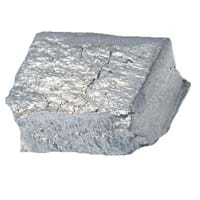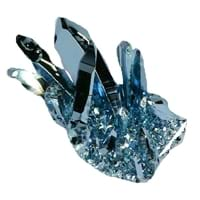Gadolinium Osmium Comparison
Periodic Table
Symbol
Gd
Os
Group Number
0
18
8
10
Period Number
6
6
Block
f block
d block
Element Family
Lanthanide
Transition Metal
CAS Number
7440542
33
7440042
99+
Space Group Name
P63/mmc
P63/mmc
Space Group Number
194.00
5
194.00
5
Facts
Interesting Facts
- Gadolinium is not found free in nature, hence it is not a native metal.
- Gadolinium metal found in minerals like Monazite and Bastnaesite.
- Osmium metal does not oxidize in air unless it is heated.
- But if it heated den it forms Osmium Tetroxide, which is highly toxic.
Sources
Found in Minerals, Mining
Found As a By-product, Found in Minerals, Mining
History
Who Discovered
Jean Charles Galissard de Marignac
Smithson Tennant
Discovery
In 1880
In 1803
Abundance
Abundance In Universe
2 * 10-7 %
22
3 * 10-7 %
21
Abundance In Sun
~0.0000002 %
25
~0.0000002 %
25
Abundance In Meteorites
0.00 %
34
0.00 %
28
Abundance In Earth's Crust
0.00 %
30
0.00 %
99+
Abundance In Oceans
0.00 %
38
Not Available
Uses
Uses & Benefits
- Its alloys are also used in making Magnets, electronic components and Data storage devices.
- Compound of Gadolinium metal are used in magnetic resonance imaging (MRI).
- Its has very limited uses and its alloys are very hard and are used in the manufacturing of pen tips, pivots, needles and electrical contacts.
- It is also used as industrial catalyst to speed up the chemical reaction.
Industrial Uses
Aerospace Industry, Electrical Industry, Electronic Industry
Aerospace Industry, Automobile Industry, Electrical Industry, Electronic Industry
Medical Uses
NA
NA
Other Uses
Alloys
Alloys
Biological Properties
Toxicity
Non Toxic
Highly Toxic
Present in Human Body
No
No
Physical Properties
Melting Point
1,311.00 °C
35
3,045.00 °C
3
Boiling Point
3,233.00 °C
25
5,027.00 °C
6
Appearance
Physical State
Solid
Solid
Color
Silvery White
Silvery Bluish-Gray
Luster
Metallic
Metallic
Hardness
Mohs Hardness
Not Available
7.00
3
Brinell Hardness
Not Available
3,490.00 MPa
1
Vickers Hardness
510.00 MPa
22
Not Available
Speed of Sound
2,680.00 m/s
34
4,940.00 m/s
11
Optical Properties
Allotropes
No
No
α Allotropes
Not Available
Not Available
β Allotropes
Not Available
Not Available
γ Allotropes
Not Available
Not Available
Chemical Properties
Chemical Formula
Gd
Os
Isotopes
Known Isotopes
26
13
35
4
Electronegativity
Pauling Electronegativity
1.20
39
2.20
4
Allred Rochow Electronegativity
1.11
29
1.52
12
Allen Electronegativity
Not Available
1.65
19
Electropositivity
Pauling Electropositivity
2.80
15
1.80
99+
Ionization Energies
1st Energy Level
593.40 kJ/mol
99+
840.00 kJ/mol
12
2nd Energy Level
1,170.00 kJ/mol
99+
1,309.80 kJ/mol
99+
3rd Energy Level
1,990.00 kJ/mol
99+
1,600.00 kJ/mol
99+
4th Energy Level
4,250.00 kJ/mol
30
Not Available
Electrochemical Equivalent
1.96 g/amp-hr
32
1.77 g/amp-hr
38
Electron Work Function
3.10 eV
35
4.83 eV
8
Other Chemical Properties
Corrosion, Flammable, Ionization, Radioactive Isotopes
Chemical Stability, Ionization, Solubility
Atomic Properties
Atomic Number
64
99+
76
40
Electron Configuration
[Xe] 4f7 5d1 6s2
[Xe] 4f14 5d6 6s2
Crystal Structure
Hexagonal Close Packed (HCP)
Hexagonal Close Packed (HCP)
Crystal Lattice
HCP-Crystal-Structure-of-Gadolinium.jpg#100
BCC-Crystal-Structure-.jpg#100
Atom
Number of Protons
64
99+
76
39
Number of Neutrons
93
37
114
25
Number of Electrons
64
99+
76
39
Radius of an Atom
Atomic Radius
180.00 pm
14
133.80 pm
99+
Covalent Radius
196.00 pm
14
Not Available
Van der Waals Radius
237.00 pm
15
216.00 pm
24
Atomic Weight
47.87 amu
99+
190.23 amu
35
Atomic Volume
19.90 cm3/mol
20
8.49 cm3/mol
99+
Adjacent Atomic Numbers
Valence Electron Potential
46.10 (-eV)
34
91.40 (-eV)
12
Lattice Constant
363.60 pm
32
273.44 pm
99+
Lattice Angles
π/2, π/2, 2 π/3
π/2, π/2, 2 π/3
Lattice C/A Ratio
1.59
9
1.58
14
Mechanical Properties
Density
Density At Room Temperature
7.90 g/cm3
99+
22.59 g/cm3
9
Density When Liquid (at m.p.)
7.40 g/cm3
31
20.00 g/cm3
1
Tensile Strength
Not Available
1,000.00 MPa
4
Viscosity
Not Available
Not Available
Vapor Pressure
Vapor Pressure at 1000 K
0.00 (Pa)
30
Not Available
Vapor Pressure at 2000 K
7.39 (Pa)
9
0.00 (Pa)
28
Elasticity properties
Shear Modulus
21.80 GPa
33
222.00 GPa
1
Bulk Modulus
37.90 GPa
34
462.00 GPa
1
Young's Modulus
54.80 GPa
35
Not Available
Poisson Ratio
0.26
23
0.25
24
Other Mechanical Properties
Ductile, Malleable
Ductile
Magnetic Properties
Magnetic Characteristics
Specific Gravity
7.90
40
22.57
2
Magnetic Ordering
Ferromagnetic
Paramagnetic
Electrical Properties
Electrical Property
Conductor
Conductor
Resistivity
1.31 nΩ·m
99+
81.20 nΩ·m
35
Electrical Conductivity
0.01 106/cm Ω
99+
0.11 106/cm Ω
18
Electron Affinity
50.00 kJ/mol
21
106.10 kJ/mol
9
Thermal Properties
Specific Heat
0.23 J/(kg K)
27
0.13 J/(kg K)
39
Molar Heat Capacity
37.03 J/mol·K
2
24.70 J/mol·K
99+
Thermal Conductivity
10.60 W/m·K
99+
87.60 W/m·K
19
Critical Temperature
Not Available
Not Available
Thermal Expansion
9.40 µm/(m·K)
99+
5.10 µm/(m·K)
99+
Enthalpy
Enthalpy of Vaporization
359.40 kJ/mol
21
627.60 kJ/mol
7
Enthalpy of Fusion
10.05 kJ/mol
36
29.30 kJ/mol
4
Enthalpy of Atomization
352.00 kJ/mol
27
669.00 kJ/mol
6
Standard Molar Entropy
68.10 J/mol.K
16
32.60 J/mol.K
99+
|
||
|
||
|












